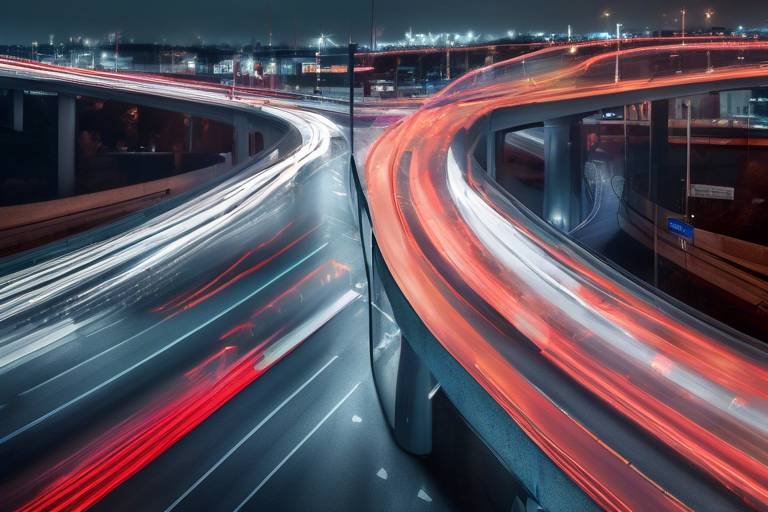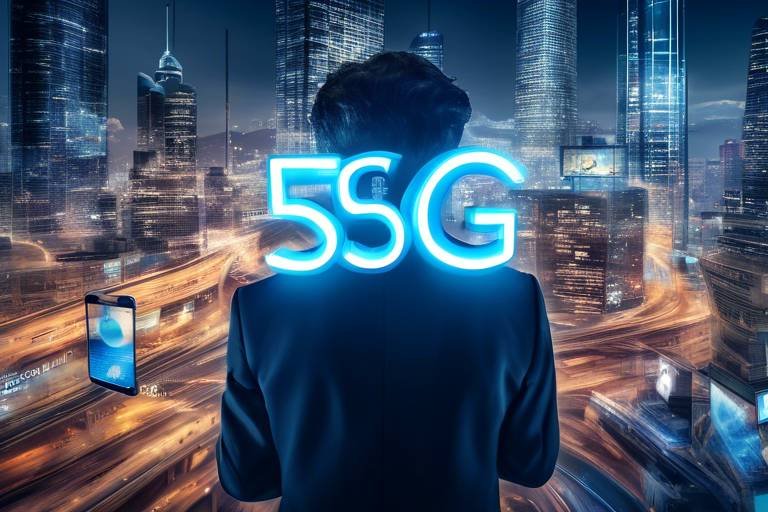Innovations in Smart Traffic Management Systems
In today's fast-paced urban environments, the need for efficient traffic management has never been more critical. With increasing population density and vehicle numbers, cities are grappling with congestion, pollution, and safety concerns. Enter smart traffic management systems, a technological revolution that promises to transform how we navigate our roads. These innovations leverage cutting-edge technologies to optimize traffic flow, reduce delays, and enhance overall urban mobility. Imagine a city where traffic lights adjust in real-time based on current conditions, where vehicles communicate with each other and the infrastructure around them, and where data analytics predict congestion before it even happens. This is not just a dream; it’s becoming a reality.
The impact of these systems extends beyond mere convenience. They play a vital role in promoting sustainability by minimizing emissions and reducing the environmental footprint of transportation. With smart traffic management, we are not just improving efficiency but also paving the way for a greener future. The integration of technologies such as the Internet of Things (IoT), artificial intelligence (AI), and big data analytics is at the forefront of this transformation, enabling cities to create more responsive and adaptive traffic management solutions.
As we delve deeper into this topic, we'll explore the key technologies driving these innovations, the myriad benefits they offer, and the challenges that still lie ahead. By understanding these elements, we can appreciate how smart traffic management systems are not only reshaping our cities but also enhancing our daily lives. So, buckle up as we embark on this journey through the world of smart traffic management!
Smart traffic management systems utilize technology to enhance traffic flow and reduce congestion, improving the overall efficiency of transportation networks in urban areas. These systems are designed to analyze real-time data from various sources, allowing city planners and traffic managers to make informed decisions that can alleviate traffic woes. Think of it as a conductor orchestrating an intricate symphony, where every instrument plays in harmony to create a seamless flow of movement.
By implementing smart traffic management, cities can significantly improve the travel experience for commuters. Imagine being able to drive through a city with synchronized traffic signals that adapt to the volume of vehicles on the road, reducing unnecessary stops and starts. This not only saves time but also contributes to lower fuel consumption and reduced emissions. The result? A win-win for both the city and its residents.
This section discusses the cutting-edge technologies such as IoT, AI, and big data analytics that are revolutionizing traffic management systems and improving decision-making processes. These technologies work together to create a holistic approach to traffic management, where data-driven insights lead to actionable strategies. For instance, IoT devices collect vast amounts of data from smart sensors and cameras placed throughout the city. This data is then analyzed using AI algorithms to predict traffic patterns and optimize signal timings.
IoT devices collect real-time data from various sources, enabling traffic systems to monitor conditions and adapt accordingly, leading to better traffic management and reduced delays. Picture a network of interconnected devices communicating seamlessly to provide a comprehensive view of traffic conditions. This integration allows for quick responses to changing situations, such as accidents or road closures, ensuring that traffic flows smoothly even in unexpected circumstances.
Advanced sensors and cameras play a crucial role in gathering traffic data, allowing for accurate monitoring and analysis of traffic patterns and incidents. These devices are capable of detecting the number of vehicles on the road, their speed, and even their types. This information is invaluable for traffic management systems that aim to optimize flow and enhance safety.
The integration of connected vehicles into traffic management systems enhances communication between vehicles and infrastructure, improving safety and traffic efficiency. Imagine your car being able to communicate with traffic lights, alerting you to green lights ahead or warning you of potential hazards. This level of connectivity not only enhances the driving experience but also contributes to a safer road environment.
AI algorithms analyze traffic data to predict congestion patterns and optimize traffic signal timings, resulting in smoother traffic flow and reduced wait times. With the ability to process vast amounts of data quickly, AI can identify trends and make recommendations that human operators might overlook. This proactive approach to traffic management is crucial for keeping urban areas moving efficiently.
Implementing smart traffic management systems leads to numerous benefits, including reduced traffic congestion, lower emissions, improved safety, and enhanced urban mobility. The advantages are multi-faceted, impacting not only the efficiency of transportation networks but also the quality of life for residents. With less time spent in traffic, people can enjoy more time with family, pursue hobbies, or simply relax.
Smart traffic management contributes to environmental sustainability by minimizing vehicle emissions through optimized traffic flow and reduced idling times at intersections. By facilitating smoother traffic movement, these systems help decrease the carbon footprint of urban transportation, aligning with global efforts to combat climate change.
By improving traffic flow and reducing congestion, smart traffic systems help to decrease the likelihood of accidents, promoting safer roadways for all users. With real-time monitoring and data analysis, traffic management can respond quickly to incidents, ensuring that emergency services can reach the scene faster and that drivers are informed of potential dangers ahead.
Despite their benefits, smart traffic management systems face challenges such as high implementation costs, data privacy concerns, and the need for continuous maintenance and updates. These obstacles can hinder the widespread adoption of these technologies, especially in smaller municipalities with limited budgets.
The initial investment required for smart traffic management systems can be substantial, posing a barrier for some municipalities and requiring careful budget planning. However, when considering the long-term savings from reduced congestion and improved efficiency, many cities find that the benefits outweigh the costs.
As traffic management systems collect vast amounts of data, concerns regarding data privacy and security must be addressed to ensure public trust and compliance with regulations. It is essential for cities to implement robust data protection measures to safeguard citizens' information while still reaping the benefits of advanced traffic management technologies.
- What are smart traffic management systems? Smart traffic management systems use technology to optimize traffic flow and reduce congestion in urban areas.
- How do IoT and AI contribute to traffic management? IoT devices collect real-time data, while AI analyzes this data to predict traffic patterns and optimize signal timings.
- What are the environmental benefits of smart traffic management? These systems help minimize vehicle emissions and reduce the carbon footprint of urban transportation.
- What challenges do smart traffic management systems face? High implementation costs and data privacy concerns are significant challenges to their widespread adoption.

Overview of Smart Traffic Management
Smart traffic management systems are revolutionizing the way we navigate urban spaces. Gone are the days of sitting in endless traffic jams, staring at the red light, and wishing for a miracle. With the integration of advanced technologies, these systems are designed to enhance traffic flow and significantly reduce congestion. Imagine a bustling city where traffic lights adjust in real-time based on the flow of vehicles, ensuring that everyone gets to their destination as quickly as possible. That's the magic of smart traffic management!
At their core, smart traffic management systems utilize a combination of Internet of Things (IoT), artificial intelligence (AI), and big data analytics to create a synchronized network of vehicles and infrastructure. This integration allows for seamless communication between traffic signals, road sensors, and even vehicles themselves, creating a dynamic environment where traffic conditions can be monitored and adjusted instantaneously. For instance, if a major accident occurs on a busy highway, the system can quickly reroute traffic, minimizing delays and improving safety.
Moreover, these systems are not just about efficiency; they're also about sustainability. By optimizing traffic patterns, smart traffic management can lead to reduced fuel consumption and lower emissions, contributing to a healthier urban environment. For example, when traffic lights are synchronized to allow for smoother transitions, vehicles spend less time idling, which directly translates to fewer pollutants being released into the atmosphere.
In a nutshell, the overview of smart traffic management reveals a future where urban mobility is not only more efficient but also more sustainable. As cities continue to grow and evolve, the demand for innovative traffic solutions will only increase. With smart traffic management systems in place, we can look forward to a world where congestion is a thing of the past, and our daily commutes become a breeze.
- What is a smart traffic management system?
A smart traffic management system uses advanced technologies to monitor and manage traffic flow, reducing congestion and improving safety. - How does IoT play a role in traffic management?
IoT devices collect real-time data from various sources, enabling better decision-making and traffic monitoring. - What are the environmental benefits of smart traffic systems?
These systems help lower emissions by optimizing traffic flow and reducing idle times. - Are there any challenges in implementing smart traffic management?
Yes, challenges include high implementation costs, data privacy concerns, and the need for ongoing maintenance.

Key Technologies Driving Innovation
In the fast-evolving world of urban transportation, several key technologies are at the forefront of revolutionizing smart traffic management systems. These innovations not only enhance the efficiency of our roads but also pave the way for a more sustainable future. At the heart of this transformation are technologies like the Internet of Things (IoT), Artificial Intelligence (AI), and big data analytics. Each of these elements plays a crucial role in creating a seamless traffic experience, reducing congestion, and making our cities more livable.
The Internet of Things is a game-changer in traffic management. By integrating IoT devices throughout urban areas, cities can collect real-time data from various sources, including traffic lights, vehicles, and even pedestrians. This interconnected network allows traffic systems to monitor conditions continuously and adapt accordingly. For instance, if a traffic jam is detected on a major route, the system can automatically adjust traffic signal timings to alleviate congestion, leading to better traffic management and significantly reduced delays.
One of the most remarkable aspects of IoT integration is the deployment of smart sensors and cameras. These advanced devices gather critical traffic data, enabling accurate monitoring and analysis of traffic patterns and incidents. Imagine a city where every intersection is equipped with smart cameras capable of detecting the number of vehicles waiting at a red light. This data can be processed in real-time to optimize traffic flows, ensuring that vehicles spend less time idling and more time moving. Furthermore, connected vehicles contribute to this ecosystem by enhancing communication between vehicles and infrastructure. This synergy not only improves safety but also boosts overall traffic efficiency, creating a more harmonious urban environment.
On the other hand, Artificial Intelligence is revolutionizing the way we analyze traffic data. AI algorithms can sift through vast amounts of information to predict congestion patterns and optimize traffic signal timings. For instance, by learning from historical traffic data, AI can identify peak traffic hours and adjust signals accordingly, resulting in smoother traffic flow and significantly reduced wait times at intersections. This predictive capability can be likened to having a personal traffic assistant that knows the best routes to take at any given time, ensuring that commuters reach their destinations faster and with less stress.
In summary, the integration of IoT and AI technologies into smart traffic management systems is not just a trend; it is a necessity for modern urban living. As cities continue to grow, the demand for efficient and sustainable transportation solutions will only increase. By leveraging these advanced technologies, urban planners and traffic management authorities can create systems that not only meet current needs but also anticipate future challenges.
- What are smart traffic management systems?
Smart traffic management systems utilize technology to enhance traffic flow, reduce congestion, and improve the overall efficiency of transportation networks in urban areas. - How does IoT improve traffic management?
IoT devices collect real-time data from various sources, allowing traffic systems to monitor conditions and adapt accordingly, leading to better traffic management and reduced delays. - What role does AI play in traffic management?
AI algorithms analyze traffic data to predict congestion patterns and optimize traffic signal timings, resulting in smoother traffic flow and reduced wait times. - What are the environmental benefits of smart traffic systems?
By optimizing traffic flow and reducing idling times, smart traffic management systems contribute to lower vehicle emissions, promoting environmental sustainability.

Internet of Things (IoT) Integration
This article explores the latest advancements in smart traffic management systems, highlighting their impact on urban mobility, efficiency, and sustainability in transportation networks.
Smart traffic management systems utilize technology to enhance traffic flow and reduce congestion, improving the overall efficiency of transportation networks in urban areas.
This section discusses the cutting-edge technologies such as IoT, AI, and big data analytics that are revolutionizing traffic management systems and improving decision-making processes.
The Internet of Things (IoT) has emerged as a game-changer in the realm of smart traffic management. By integrating IoT devices into traffic systems, cities can collect and analyze real-time data from various sources, including vehicles, road sensors, and even pedestrians. Imagine a network of smart traffic lights that can communicate with each other and adjust their timings based on the current traffic situation. This level of connectivity allows for a more responsive traffic management system, reducing delays and enhancing overall efficiency.
At the heart of IoT integration are smart sensors and cameras. These devices are strategically placed throughout urban areas to monitor traffic patterns and detect incidents as they happen. For instance, if a traffic jam occurs, the system can automatically reroute vehicles to alleviate congestion. Furthermore, connected vehicles can share their location and speed with traffic management systems, enabling real-time adjustments to traffic signals and signage. This seamless communication between vehicles and infrastructure not only optimizes traffic flow but also enhances safety on the roads.
Moreover, the data collected through IoT devices can be analyzed to identify long-term trends and patterns in traffic behavior. This information is invaluable for city planners and traffic engineers, as it helps them make informed decisions about infrastructure improvements and traffic management strategies. For example, if data shows that a particular intersection consistently experiences high traffic volume during certain hours, city planners can consider implementing measures such as additional lanes or improved public transport options to mitigate congestion.
In summary, the integration of IoT in traffic management systems is paving the way for smarter, more efficient urban mobility solutions. As cities continue to embrace these technologies, we can expect to see significant improvements in traffic flow, reduced congestion, and ultimately, a more sustainable approach to urban transportation.
Implementing smart traffic management systems leads to numerous benefits, including reduced traffic congestion, lower emissions, improved safety, and enhanced urban mobility.
Smart traffic management contributes to environmental sustainability by minimizing vehicle emissions through optimized traffic flow and reduced idling times at intersections.
By improving traffic flow and reducing congestion, smart traffic systems help to decrease the likelihood of accidents, promoting safer roadways for all users.
Despite their benefits, smart traffic management systems face challenges such as high implementation costs, data privacy concerns, and the need for continuous maintenance and updates.
The initial investment required for smart traffic management systems can be substantial, posing a barrier for some municipalities and requiring careful budget planning.
As traffic management systems collect vast amounts of data, concerns regarding data privacy and security must be addressed to ensure public trust and compliance with regulations.
- What is a smart traffic management system?
A smart traffic management system uses technology to optimize traffic flow and reduce congestion in urban areas.
- How does IoT improve traffic management?
IoT devices collect real-time data, allowing traffic systems to adapt and respond to changing conditions, leading to improved traffic flow.
- What are the environmental benefits of smart traffic systems?
These systems help lower vehicle emissions by reducing idling times and optimizing traffic patterns.
- Are there any challenges associated with smart traffic management?
Yes, challenges include high implementation costs, data privacy concerns, and the need for ongoing maintenance.

Smart Sensors and Cameras
In the realm of smart traffic management, are the unsung heroes that collect vital data, enabling cities to understand and respond to traffic conditions in real-time. These advanced devices are not just passive observers; they actively monitor traffic flow, detect incidents, and analyze patterns, creating a comprehensive picture of urban mobility. Imagine a bustling city where every traffic light, intersection, and road is equipped with intelligent sensors that communicate with each other, sharing data and insights to keep traffic moving smoothly. This is the future that smart sensors and cameras are helping to create.
At the heart of these systems are various types of sensors, including inductive loop sensors, radar sensors, and video cameras. Each plays a critical role in gathering data:
- Inductive Loop Sensors: Embedded in the road surface, these sensors detect the presence of vehicles by measuring changes in inductance, allowing for precise vehicle counting and classification.
- Radar Sensors: These sensors use radio waves to monitor vehicle speed and distance, making them ideal for traffic flow analysis.
- Video Cameras: Equipped with advanced analytics software, these cameras can identify traffic patterns, recognize license plates, and even detect incidents such as accidents or road obstructions.
The data collected from these sensors and cameras is invaluable for traffic management systems. It allows for real-time adjustments to traffic signals, leading to improved traffic flow and reduced congestion. For example, if a camera detects a significant number of vehicles waiting at a red light, the traffic management system can automatically extend the green light duration to alleviate the buildup. This dynamic response is akin to a conductor leading an orchestra, ensuring that every element works in harmony to create a seamless transportation experience.
Moreover, the integration of smart sensors and cameras with other technologies, such as the Internet of Things (IoT) and Artificial Intelligence (AI), enhances their effectiveness. The data can be analyzed using AI algorithms to predict traffic patterns and optimize signal timings, resulting in smoother traffic flow and shorter travel times. This synergy between technology and infrastructure not only improves efficiency but also contributes to a more sustainable urban environment by reducing emissions and energy consumption.
In conclusion, smart sensors and cameras are pivotal in the evolution of traffic management systems. They provide the essential data needed to make informed decisions, ultimately leading to safer and more efficient roadways. As cities continue to invest in these technologies, we can expect to see a transformation in how we navigate urban spaces, making our journeys not just faster, but also more enjoyable.
1. What are smart sensors and cameras used for in traffic management?
Smart sensors and cameras are used to monitor traffic flow, detect incidents, and analyze patterns, providing real-time data that helps manage urban mobility effectively.
2. How do smart sensors improve traffic flow?
They collect data on vehicle presence and movement, allowing traffic management systems to adjust signal timings dynamically, reducing congestion and improving travel times.
3. Are there privacy concerns associated with the use of smart cameras?
Yes, as these cameras collect vast amounts of data, there are concerns regarding data privacy and security. It's essential for municipalities to address these issues to maintain public trust.
4. Can smart sensors help reduce vehicle emissions?
Absolutely! By optimizing traffic flow and reducing idling times at intersections, smart sensors contribute to lower vehicle emissions and a more sustainable urban environment.

Connected Vehicles
Connected vehicles are at the forefront of the smart traffic management revolution, acting as the bridge between individual vehicles and the broader transportation network. Imagine a world where your car not only knows where you are but can also communicate with traffic lights, other vehicles, and even the road itself. This is not science fiction; it’s the reality of connected vehicle technology. By integrating advanced communication systems, these vehicles can send and receive real-time data, which enhances traffic efficiency and safety. For instance, when a connected vehicle approaches a traffic signal, it can receive updates about the signal's status and adjust its speed accordingly, reducing the likelihood of sudden stops and starts. This leads to smoother traffic flow and less congestion on the roads.
The benefits of connected vehicles extend beyond mere convenience. They contribute to a more organized traffic ecosystem by enabling vehicle-to-vehicle (V2V) and vehicle-to-infrastructure (V2I) communication. With V2V communication, vehicles can share information about road conditions, potential hazards, and traffic jams. This real-time data exchange allows drivers to make informed decisions, such as rerouting to avoid congested areas. On the other hand, V2I communication allows vehicles to interact with traffic signals, signage, and even parking systems, optimizing the overall traffic management experience. For example, if a traffic light detects a buildup of vehicles, it can automatically extend the green light duration to alleviate congestion. This kind of intelligent response not only saves time but also reduces fuel consumption and emissions.
Moreover, connected vehicles are equipped with advanced sensors and GPS technology, which play a crucial role in enhancing road safety. These vehicles can detect nearby obstacles and alert drivers to potential dangers, such as pedestrians crossing the road or other vehicles making unexpected maneuvers. This proactive approach to safety can significantly reduce the number of accidents, making our roads safer for everyone. In fact, studies have shown that the widespread adoption of connected vehicle technology could lead to a significant decrease in traffic-related fatalities.
However, the integration of connected vehicles into smart traffic management systems is not without its challenges. Issues such as data privacy and cybersecurity are paramount. As vehicles collect and share vast amounts of data, ensuring that this information is secure from potential threats is critical. Additionally, there is a need for standardized protocols to facilitate communication between different makes and models of vehicles and infrastructure. Without these standards, the full potential of connected vehicles cannot be realized.
In summary, connected vehicles are transforming the landscape of urban mobility by fostering communication between vehicles and traffic management systems. They not only enhance traffic efficiency but also promote safety and sustainability. As we continue to embrace these innovations, it’s essential to address the accompanying challenges to fully harness their potential for a smarter, safer, and more efficient transportation future.
- What are connected vehicles? Connected vehicles are equipped with technology that allows them to communicate with other vehicles and infrastructure, enhancing traffic management and safety.
- How do connected vehicles improve traffic flow? By sharing real-time data with traffic signals and other vehicles, connected vehicles can adjust their speed and route to avoid congestion.
- What are the safety benefits of connected vehicles? They can detect obstacles and hazards, alerting drivers and potentially reducing the number of accidents.
- What challenges do connected vehicles face? Data privacy, cybersecurity, and the need for standardized communication protocols are significant challenges that must be addressed.

Artificial Intelligence Applications
Artificial Intelligence (AI) is transforming the landscape of smart traffic management systems in remarkable ways. Imagine a world where traffic lights adjust themselves based on real-time traffic conditions, or where vehicles communicate with one another to prevent accidents. This is not science fiction; it's the power of AI at work. By analyzing vast amounts of traffic data, AI algorithms can predict congestion patterns and optimize traffic signal timings, leading to smoother traffic flow and significantly reduced wait times.
One of the most exciting applications of AI in traffic management is its ability to learn from historical data. Just like how we learn from past experiences, AI systems can analyze previous traffic patterns to forecast future conditions. This predictive capability allows traffic management centers to proactively implement measures that alleviate congestion before it becomes a problem. For instance, if an AI system identifies a recurring traffic jam at a particular intersection during rush hour, it can suggest adjustments to signal timings or even recommend alternative routes to drivers through connected navigation apps.
Moreover, AI can enhance the efficiency of public transportation systems. By analyzing data from buses, trains, and other transit options, AI can optimize schedules and routes based on real-time demand. This means fewer delays and better service for commuters, making public transport a more attractive option for urban dwellers. As a result, we see a shift in commuter behavior, with more people opting for public transportation over personal vehicles, ultimately reducing the number of cars on the road.
Another fascinating aspect of AI in traffic management is its integration with connected vehicles. These vehicles, equipped with advanced sensors and communication technologies, can share information with traffic management systems. For example, if a connected vehicle detects a traffic jam ahead, it can relay this information back to the traffic management system, which can then adjust traffic signals to mitigate the congestion. This real-time communication creates a dynamic traffic management ecosystem that is responsive and adaptive.
In summary, the applications of AI in smart traffic management systems are vast and varied. From predictive analytics that enhance traffic flow to real-time communication between vehicles and infrastructure, AI is paving the way for more efficient and sustainable urban mobility. However, as we embrace these innovations, it is crucial to remain aware of the potential challenges, such as data privacy and the need for continuous updates, to ensure that these systems serve the public effectively.
- What is the role of AI in traffic management? AI helps in analyzing traffic data to predict congestion, optimize signal timings, and enhance communication between vehicles and infrastructure.
- How does AI improve public transportation? AI optimizes schedules and routes based on real-time demand, leading to fewer delays and better service for commuters.
- Are there any risks associated with AI in traffic management? Yes, concerns regarding data privacy and the need for continuous system updates are important to address for effective implementation.

Benefits of Smart Traffic Management
Implementing smart traffic management systems is like giving a city a brain. These systems are designed to analyze and respond to traffic conditions in real-time, leading to a myriad of benefits that enhance urban mobility and overall quality of life. Imagine a bustling city where traffic flows smoothly, where commuters spend less time stuck in jams, and where the air is cleaner because vehicles are moving efficiently. This is not just a dream; it's the reality that smart traffic management systems are creating.
One of the most significant advantages of these systems is the reduction in traffic congestion. By utilizing advanced technologies such as IoT sensors and AI algorithms, cities can monitor traffic patterns and adjust signals dynamically to optimize flow. This means fewer bottlenecks and a smoother ride for everyone. Picture this: you’re on your way to work, and instead of stopping at every red light, you glide through intersections with minimal delays. This is the kind of experience that smart traffic management aims to provide.
Moreover, the environmental impact of these systems cannot be overstated. With optimized traffic flow, vehicles spend less time idling, which in turn leads to lower emissions. According to recent studies, cities that have implemented smart traffic systems have seen a significant decrease in greenhouse gas emissions. For example, a city that previously emitted 100 tons of CO2 per day might reduce this to 75 tons after implementing smart traffic solutions. This reduction not only benefits the planet but also improves air quality for residents, making urban areas more livable.
In addition to environmental benefits, smart traffic management systems enhance public safety. By reducing congestion, the likelihood of accidents decreases. When traffic flows smoothly, drivers are less likely to engage in risky behaviors like sudden lane changes or aggressive acceleration. Furthermore, these systems can respond quickly to incidents, rerouting traffic and alerting emergency services in real-time. Imagine a scenario where an accident occurs, and within moments, the traffic signals adjust to divert vehicles away from the scene, minimizing further incidents and ensuring that help arrives swiftly.
To summarize, the benefits of smart traffic management systems include:
- Reduced Traffic Congestion: Enhanced flow leads to shorter travel times.
- Lower Emissions: Optimized routes decrease fuel consumption and pollution.
- Increased Safety: Fewer accidents and quicker emergency response times.
As cities continue to grow and evolve, the need for innovative solutions to manage traffic becomes increasingly vital. Smart traffic management systems are not just a luxury; they are a necessity for sustainable urban development. By embracing these technologies, cities can ensure a brighter, more efficient future for all their residents.
Q1: What are smart traffic management systems?
A1: Smart traffic management systems utilize advanced technologies such as IoT, AI, and big data analytics to monitor and manage traffic flow in real-time, improving efficiency and reducing congestion.
Q2: How do these systems reduce traffic congestion?
A2: By analyzing real-time traffic data, smart systems can dynamically adjust traffic signals and provide alternate routes to drivers, minimizing bottlenecks and ensuring smoother traffic flow.
Q3: What environmental benefits do smart traffic systems offer?
A3: These systems help reduce vehicle emissions by optimizing traffic flow, leading to less idling and lower fuel consumption, which contributes to cleaner air and a healthier environment.
Q4: Are there any safety improvements associated with smart traffic management?
A4: Yes, by reducing congestion and enabling quicker emergency response, smart traffic systems significantly enhance public safety and decrease the likelihood of accidents.

Environmental Impact
The implementation of smart traffic management systems is not just a technological advancement; it's a significant step towards enhancing our environment. These systems play a pivotal role in reducing vehicle emissions, which is crucial in the fight against climate change. By optimizing traffic flow and minimizing congestion, smart traffic management helps to decrease the time vehicles spend idling at intersections, leading to less fuel consumption and lower greenhouse gas emissions.
Imagine a busy city intersection where cars are constantly stopping and starting. This stop-and-go traffic not only frustrates drivers but also contributes to higher emissions. Smart traffic systems utilize real-time data and analytics to adjust traffic signals dynamically, allowing for smoother transitions and reducing the likelihood of traffic jams. The result? A significant drop in emissions from vehicles, which is a win for both the environment and urban dwellers.
Furthermore, these systems often integrate with public transportation networks, encouraging more people to opt for buses or trains instead of personal vehicles. This shift can lead to a dramatic reduction in the number of cars on the road. For instance, cities that have adopted smart traffic management have reported a decrease in single-occupancy vehicle trips, which directly correlates with lower emissions and improved air quality.
To illustrate the impact of smart traffic management on emissions, consider the following table:
| City | Emissions Reduction (%) | Year Implemented |
|---|---|---|
| City A | 25% | 2018 |
| City B | 30% | 2020 |
| City C | 20% | 2019 |
As we can see, cities that have embraced smart traffic management systems have experienced notable reductions in emissions. This not only contributes to a healthier environment but also enhances the quality of life for residents. Cleaner air leads to fewer health issues, which can also reduce healthcare costs—another layer of benefit from these systems.
In summary, the environmental impact of smart traffic management systems is profound. By leveraging technology to improve traffic flow and reduce congestion, cities can significantly lower their carbon footprints. This shift not only supports global sustainability goals but also fosters healthier urban living conditions. As we continue to innovate and embrace these technologies, the potential for a greener future becomes more attainable.
- What are smart traffic management systems?
Smart traffic management systems use technology to monitor and control traffic flow in urban areas, improving efficiency and reducing congestion. - How do these systems contribute to environmental sustainability?
By optimizing traffic flow and reducing idling times, smart traffic systems lower vehicle emissions, contributing to cleaner air and a healthier environment. - What technologies are involved in smart traffic management?
Key technologies include IoT devices, AI algorithms, smart sensors, and connected vehicles that work together to enhance traffic management. - Are there any challenges in implementing smart traffic systems?
Yes, challenges include high implementation costs, data privacy concerns, and the need for continuous maintenance and updates.

Enhancing Public Safety
In today's fast-paced world, ensuring public safety on our roads is more crucial than ever. Smart traffic management systems play a pivotal role in this domain by leveraging technology to create safer environments for all road users. Imagine a city where traffic lights communicate with vehicles, alerting them to potential hazards or changing traffic conditions. This isn’t just a futuristic dream; it’s becoming a reality thanks to innovations in smart traffic systems.
One of the primary ways these systems enhance public safety is by reducing the likelihood of accidents. With real-time data collection from various sources, including smart sensors and cameras, traffic management systems can analyze patterns and detect anomalies that may indicate potential dangers. For instance, if a vehicle suddenly stops or a pedestrian is detected in a crosswalk, the system can adjust traffic signals or alert nearby drivers, significantly decreasing the chances of collisions.
Moreover, smart traffic management systems contribute to safer roadways through:
- Improved Traffic Flow: By optimizing traffic signals based on real-time data, these systems minimize congestion, which is a major contributor to accidents. Less stop-and-go traffic means fewer opportunities for rear-end collisions.
- Emergency Vehicle Prioritization: In emergencies, time is of the essence. Smart systems can detect approaching emergency vehicles and change traffic lights to green, allowing them to navigate through traffic more efficiently.
- Pedestrian Safety Measures: Enhanced pedestrian detection systems ensure that crosswalks are safe. Traffic lights can automatically adjust to give pedestrians ample time to cross, while alerts can inform drivers to slow down in pedestrian-heavy areas.
Additionally, the integration of connected vehicles into these systems further amplifies safety measures. Vehicles equipped with communication technology can share information with traffic management systems, alerting them about road conditions, accidents, or even hazardous weather. This interconnectedness creates a comprehensive safety network that protects drivers, cyclists, and pedestrians alike.
However, the benefits of smart traffic management systems go beyond just reducing accidents. They also foster a culture of safety awareness among drivers. With real-time alerts and notifications, drivers become more conscious of their surroundings, leading to more cautious driving behaviors. It’s like having a co-pilot that keeps you informed and safe on the road.
In conclusion, as urban areas continue to grow, the need for enhanced public safety becomes increasingly critical. Smart traffic management systems not only improve traffic flow but also create a safer environment for everyone. By investing in these technologies, cities can ensure that their streets are not only efficient but also secure, paving the way for a brighter, safer future.
- What are smart traffic management systems? Smart traffic management systems utilize technology to monitor and manage traffic flow, enhancing safety and efficiency in urban transportation.
- How do these systems improve public safety? They reduce congestion, optimize traffic signals, prioritize emergency vehicles, and enhance pedestrian safety through real-time data analysis.
- Are there any downsides to implementing smart traffic systems? Yes, challenges include high implementation costs, data privacy concerns, and the need for ongoing maintenance and updates.

Challenges and Limitations
While the advancements in smart traffic management systems are impressive, they are not without their challenges and limitations. One of the most significant hurdles is the high cost of implementation. Municipalities often face substantial initial investments to upgrade existing infrastructure and integrate new technologies. This can be a daunting task, especially for smaller cities with limited budgets. The cost encompasses not only the purchase of advanced sensors and software but also the installation and ongoing maintenance of these systems. Without careful budget planning and funding strategies, many cities may struggle to adopt these essential technologies.
Another critical issue is data privacy. As smart traffic management systems collect vast amounts of data from various sources, including vehicles and pedestrians, concerns surrounding data security and privacy are paramount. Citizens may feel uneasy knowing that their movements are being tracked, raising questions about how this data is stored, used, and protected. To gain public trust, municipalities must ensure compliance with regulations and implement robust data protection measures. This challenge is not just about technology; it’s about building a transparent relationship with the community.
Additionally, the need for continuous maintenance and updates presents another challenge. Technology evolves rapidly, and smart traffic systems must keep pace with the latest advancements to remain effective. This requires ongoing investment in both hardware and software, as well as training for personnel who will manage these systems. Without regular updates, traffic management systems can become obsolete, leading to inefficiencies and potential safety hazards.
In summary, while smart traffic management systems offer numerous advantages, the challenges associated with implementation costs, data privacy, and maintenance are significant. Addressing these issues is crucial for cities aiming to leverage technology for improved urban mobility. As we move forward, it will be essential for stakeholders to collaborate and find innovative solutions to overcome these barriers.
- What are smart traffic management systems?
Smart traffic management systems use technology to optimize traffic flow, reduce congestion, and enhance overall transportation efficiency in urban areas.
- What technologies are involved in smart traffic management?
Key technologies include the Internet of Things (IoT), artificial intelligence (AI), big data analytics, smart sensors, and connected vehicles.
- How do smart traffic systems benefit the environment?
They help minimize vehicle emissions by optimizing traffic flow, reducing idling times, and promoting better driving behaviors.
- What are the privacy concerns associated with these systems?
As these systems collect extensive data on traffic patterns and user movements, there are significant concerns regarding data security and individual privacy.

Cost of Implementation
Implementing smart traffic management systems can be a daunting task, primarily due to the **high initial costs** associated with the technology. Municipalities and urban planners often find themselves grappling with budget constraints, making it essential to carefully evaluate the financial implications before embarking on such a project. The costs can vary significantly based on the scale of the implementation, the technologies used, and the existing infrastructure. For instance, cities with outdated traffic systems may face higher expenses as they need to upgrade their entire framework to accommodate new technologies.
To give you a clearer picture, let’s break down some of the key components that contribute to the overall cost:
- Infrastructure Upgrades: This includes the installation of smart traffic signals, sensors, cameras, and communication networks. Upgrading existing infrastructure can be particularly costly.
- Software Development: Custom software solutions that integrate various technologies for traffic management can require significant investment, especially if they need to be tailored to specific city needs.
- Data Management Systems: Collecting, storing, and analyzing the vast amounts of data generated by smart traffic systems necessitates robust data management solutions, which can further inflate costs.
- Training and Maintenance: Staff will need training to manage and operate these systems effectively, and ongoing maintenance is essential to keep everything running smoothly.
Despite the initial investment, many experts argue that the long-term benefits far outweigh the costs. For example, cities that adopt smart traffic management systems often see a reduction in traffic congestion, which can lead to increased productivity and economic growth. Moreover, the environmental benefits, such as lower emissions and improved air quality, can also translate into cost savings for municipalities in the long run.
Ultimately, the key to successful implementation lies in strategic planning and securing funding through various channels, including government grants, public-private partnerships, and innovative financing solutions. By viewing the costs as an investment in the future of urban mobility, cities can pave the way for a more efficient and sustainable transportation network.
- What are the primary benefits of smart traffic management systems?
Smart traffic management systems enhance traffic flow, reduce congestion, lower emissions, and improve public safety. - How can cities fund the implementation of these systems?
Cities can explore government grants, public-private partnerships, and innovative financing methods to support their smart traffic initiatives. - What technologies are commonly used in smart traffic management?
Key technologies include IoT devices, AI algorithms, smart sensors, and connected vehicle systems. - Are there any privacy concerns related to smart traffic management?
Yes, as these systems collect vast amounts of data, it is crucial to address data privacy and security issues to maintain public trust.

Data Privacy Issues
As smart traffic management systems become increasingly sophisticated, are emerging as a significant concern. These systems rely on vast amounts of data collected from various sources, including vehicles, traffic cameras, and sensors. While this data is essential for optimizing traffic flow and enhancing urban mobility, it also raises questions about how that information is collected, stored, and used. Residents may feel uneasy knowing that their movements are being tracked, leading to a potential erosion of public trust.
One of the primary challenges is ensuring that the data collected is handled responsibly. Traffic management systems can gather sensitive information, including personal identifiers and location data, which, if mishandled, could lead to privacy violations. It's crucial for municipalities and technology providers to implement robust security measures to protect this data from unauthorized access or breaches.
Moreover, transparency is key. Citizens have the right to know what data is being collected and how it will be used. This calls for clear communication from city officials and technology developers about their data policies. To address these concerns, many cities are adopting data governance frameworks that outline data usage, sharing protocols, and retention policies. These frameworks aim to ensure compliance with regulations such as the General Data Protection Regulation (GDPR) and the California Consumer Privacy Act (CCPA).
Here are some important considerations regarding data privacy in smart traffic management:
- Informed Consent: Users should be informed about the data being collected and give explicit consent for its use.
- Data Anonymization: Implementing techniques to anonymize data can help protect individual privacy while still allowing for valuable insights.
- Regular Audits: Conducting regular audits of data collection and usage practices can help ensure compliance with privacy standards.
Ultimately, the success of smart traffic management systems hinges not only on their technical capabilities but also on the public's trust in how their data is managed. As cities continue to evolve these systems, striking a balance between innovation and privacy will be crucial for fostering a sustainable and efficient urban transportation network.
Q1: What types of data are collected by smart traffic management systems?
A1: Smart traffic management systems collect various data types, including vehicle counts, traffic speeds, and real-time location data from connected vehicles and sensors.
Q2: How is data privacy ensured in these systems?
A2: Data privacy is ensured through measures such as data anonymization, secure data storage, and adherence to privacy regulations like GDPR and CCPA.
Q3: Can I opt-out of data collection in my area?
A3: While options may vary by location, many municipalities provide mechanisms for residents to opt-out of certain data collection practices. It's best to check with local authorities for specific policies.
Q4: What happens if there is a data breach?
A4: In the event of a data breach, municipalities are typically required to notify affected individuals and take steps to mitigate the breach's impact, including enhancing security measures.
Frequently Asked Questions
- What are smart traffic management systems?
Smart traffic management systems are advanced technological solutions designed to improve traffic flow, reduce congestion, and enhance overall transportation efficiency in urban areas. They utilize various technologies, including IoT, AI, and big data analytics, to monitor and manage traffic conditions in real-time.
- How do IoT devices contribute to traffic management?
IoT devices play a pivotal role in smart traffic management by collecting real-time data from various sources, such as sensors and cameras. This data helps traffic systems monitor conditions, adapt to changes, and optimize traffic flow, ultimately reducing delays and improving the overall driving experience.
- What benefits do smart traffic management systems offer?
Implementing smart traffic management systems leads to numerous advantages, including:
- Reduced traffic congestion
- Lower emissions and improved air quality
- Enhanced public safety through decreased accident rates
- Better urban mobility for all road users
- What challenges do municipalities face when implementing these systems?
While smart traffic management systems offer significant benefits, they also come with challenges such as:
- High implementation costs, which may deter some municipalities
- Data privacy concerns regarding the vast amounts of data collected
- The need for continuous maintenance and updates to keep systems running efficiently
- How does AI improve traffic management?
AI algorithms analyze traffic data to predict congestion patterns and optimize traffic signal timings. This results in smoother traffic flow, reduced wait times at intersections, and an overall improvement in the efficiency of the transportation network.
- What is the environmental impact of smart traffic management?
Smart traffic management systems contribute to environmental sustainability by minimizing vehicle emissions. By optimizing traffic flow and reducing idling times at intersections, these systems help create cleaner air and a healthier urban environment.



















